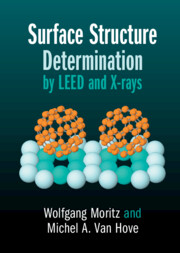Book contents
- Surface Structure Determination by LEED and X-rays
- Surface Structure Determination by LEED and X-rays
- Copyright page
- Contents
- Preface
- List of Abbreviations
- List of Major Symbols
- Glossary
- 1 Introduction
- 2 Basic Elements
- 3 LEED Experiment
- 4 Interpretation of the Diffraction Pattern
- 5 LEED Theory
- 6 LEED Theory
- 7 Surface X-ray Diffraction
- Appendices
- References
- Index
3 - LEED Experiment
Published online by Cambridge University Press: 18 August 2022
- Surface Structure Determination by LEED and X-rays
- Surface Structure Determination by LEED and X-rays
- Copyright page
- Contents
- Preface
- List of Abbreviations
- List of Major Symbols
- Glossary
- 1 Introduction
- 2 Basic Elements
- 3 LEED Experiment
- 4 Interpretation of the Diffraction Pattern
- 5 LEED Theory
- 6 LEED Theory
- 7 Surface X-ray Diffraction
- Appendices
- References
- Index
Summary
This chapter describes specialised equipment and techniques used to perform LEED experiments and to measure intensities of diffracted LEED beams. An overview of the most common setups for experiments will be given. The diffraction geometry is important for the comparison of experimental LEED data with theory and will, thus, be covered in some detail. For the measurement of LEED intensities, close attention will be paid in particular to the preparation of the sample, the accurate alignment of the sample and the physical properties of the detectors, such as the frequently used video cameras. The instrumental response function is one aspect of detectors that can affect the measured intensities, most notably spot profiles used to measure lateral dimensions such as island sizes and disorder. Among various LEED systems that are available on the market, two types will be addressed in relatively more detail, as they provide higher resolution (i.e., are able to detect structural correlations over larger distances along the surface): spot profile analysis LEED (SPA-LEED) and low-energy electron microscope (LEEM). Finally, instrumentation will be described that has been developed for more targeted applications, such as electron-beam sensitive surfaces, and surfaces with micro- or nanoscale structures.
Information
- Type
- Chapter
- Information
- Surface Structure Determination by LEED and X-rays , pp. 57 - 84Publisher: Cambridge University PressPrint publication year: 2022
